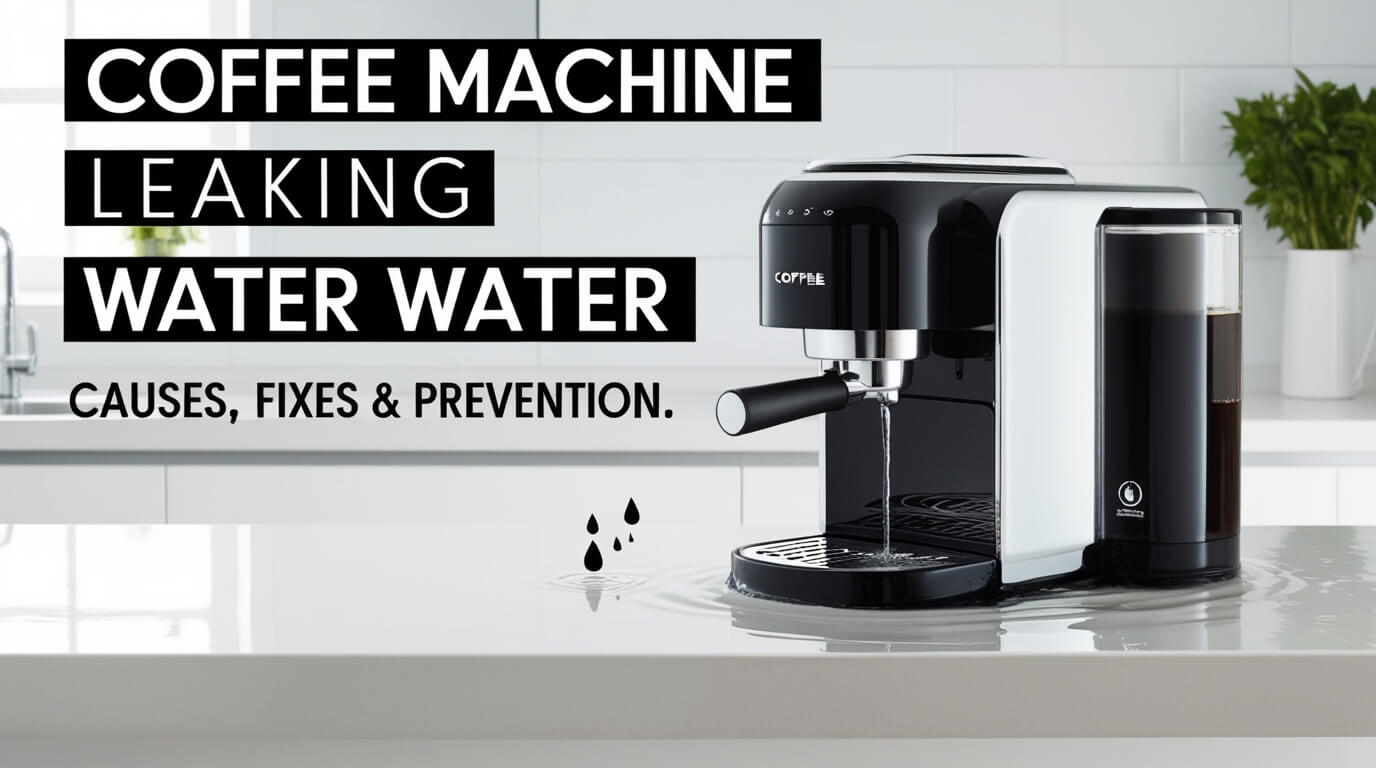
Is your morning brew turning into a messy affair? A coffee machine leaking water can be frustrating and potentially damaging to your kitchen counters. This comprehensive guide will help you identify the source of leaks, troubleshoot common issues, and keep your coffee maker in top shape.
Spotting the Signs
Common signs of a leaking coffee maker
Water puddles, drips, or stains around your coffee machine are telltale signs of a leak. You might notice:
- Moisture under the machine
- Water dripping from the bottom or sides
- Unusual noises during brewing
- Incomplete coffee cycles
Why addressing leaks promptly is crucial
Ignoring a leaky coffee maker can lead to:
- Electrical hazards
- Mold growth
- Damage to countertops or cabinets
- Increased energy bills
- Subpar coffee quality
Quick action can save you money and ensure your safety.
Identifying the Source of the Leak
Top of the machine leaks
Leaks from the top often stem from:
- Overfilled water reservoir
- Cracked lid
- Loose or damaged water tank seals
Check these areas first when you spot water on your countertop.
Bottom of the machine leaks
Water pooling under your coffee maker? Look for:
- Worn-out internal seals
- Clogged water lines
- Faulty water pumps
- Cracked internal components
These issues often require a closer inspection.
Leaks around the carafe or brew basket
If you notice drips while pouring or brewing, check:
- Warped brew basket
- Misaligned carafe lid
- Clogged drip tray
- Damaged carafe
A properly fitted carafe and clean brew basket can prevent many leaks.
Common Causes of Coffee Machine Leaks
Worn-out seals and gaskets
Over time, rubber seals and gaskets can dry out, crack, or lose their shape. This leads to gaps where water can escape.
Clogged or damaged water lines
Mineral buildup or physical damage to water lines can cause leaks. Regular cleaning helps prevent these issues.
Cracked water reservoir
Temperature changes and physical stress can crack plastic reservoirs. Inspect yours regularly for hairline fractures.
Faulty valves or pumps
Internal components like valves and pumps can wear out, leading to leaks. These often require professional repair.
Scale buildup and mineral deposits
Hard water leaves mineral deposits that can obstruct water flow, causing pressure buildup and leaks.
Troubleshooting Steps for a Leaking Coffee Maker
Safety precautions before inspection
Before you start poking around:
- Unplug the machine
- Let it cool completely
- Empty the water reservoir
- Remove the carafe
Safety first – always!
Step-by-step diagnostic process
- Visual inspection: Look for obvious cracks or damage
- Water test: Run a brew cycle with just water
- Seal check: Examine all visible seals and gaskets
- Internal inspection: If comfortable, remove the outer casing
Tools you might need
- Flashlight
- Soft cloth
- Screwdriver set
- Vinegar (for cleaning)
Having these on hand will make your inspection easier.
DIY Fixes for Minor Leaks
Cleaning and descaling your coffee machine
Regular cleaning prevents many leaks. Here’s a simple process:
- Mix equal parts water and white vinegar
- Run this solution through a brew cycle
- Rinse by running 2-3 cycles with clean water
Do this monthly to keep your machine in top shape.
Replacing seals and gaskets
For accessible seals:
- Remove the old seal
- Clean the area thoroughly
- Install the new seal, ensuring proper fit
Always use manufacturer-approved parts for replacements.
Unclogging water lines
To clear minor clogs:
- Use a mixture of water and vinegar
- Run several brew cycles
- Flush with clean water
For stubborn clogs, consult a professional.
When to Seek Professional Repair
Signs that indicate a major problem
Consider professional help if you notice:
- Electrical issues (sparks, burning smell)
- Persistent leaks after DIY attempts
- Strange noises during operation
- Visible damage to internal components
Don’t risk further damage – seek expert advice.
Cost considerations: Repair vs. replacement
Weigh repair costs against the price of a new machine. Factors to consider:
- Age of your coffee maker
- Availability of parts
- Cost of professional repair
- Features of newer models
Sometimes, investing in a new, efficient machine is more cost-effective.
Preventing Future Coffee Machine Leaks
Regular maintenance tips
- Clean your machine monthly
- Descale every 3-6 months (more often for hard water)
- Replace water filters as recommended
- Inspect seals and gaskets regularly
A little care goes a long way in preventing leaks.
Proper usage and handling
- Don’t overfill the water reservoir
- Avoid moving the machine while it’s hot
- Use the correct grind size for your machine
- Clean spills immediately to prevent seepage
Treat your coffee maker with care, and it’ll return the favor.
Water quality and its impact on your machine
Hard water can wreak havoc on coffee makers. Consider:
- Using filtered water
- Installing a water softener
- Regular descaling treatments
Better water quality means fewer leaks and better-tasting coffee.
Choosing a Leak-Resistant Coffee Maker
Features to look for in durable coffee machines
When shopping for a new machine, prioritize:
- Stainless steel construction
- Removable water reservoirs
- Programmable cleaning cycles
- Warranty coverage
Investing in quality upfront can save you from future headaches.
Top brands known for reliability
While individual experiences may vary, these brands often receive high marks for durability:
- Technivorm Moccamaster
- Breville
- Bonavita
- Cuisinart
Research customer reviews and reliability ratings before making a purchase.
Environmental and Cost Implications of Coffee Maker Leaks
Water waste and energy efficiency
A leaking coffee machine wastes more than just water:
- Increased water bills
- Higher electricity consumption
- Potential damage to surrounding areas
Fixing leaks helps conserve resources and reduce your carbon footprint.
Long-term savings from proper maintenance
Regular maintenance might seem like a hassle, but it pays off:
- Extended machine lifespan
- Fewer repair costs
- Consistent coffee quality
- Lower utility bills
Think of it as an investment in your daily coffee ritual.
Conclusion
A coffee machine leaking water doesn’t have to spell the end of your favorite appliance. With regular care, prompt attention to issues, and a bit of know-how, you can keep your coffee maker running smoothly for years to come.
Remember:
- Regular cleaning and descaling are key
- Address leaks promptly to prevent further damage
- Don’t hesitate to seek professional help for major issues
- Consider water quality and usage habits
By following these tips, you’ll ensure that your morning cup of joe remains a pleasure, not a puddle. Here’s to leak-free brewing and perfect coffee every time!






